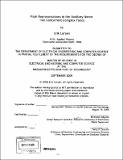| dc.contributor.advisor | Bertrand Delgutte. | en_US |
| dc.contributor.author | Larsen, Erik, Ph. D. Massachusetts Institute of Technology | en_US |
| dc.contributor.other | Massachusetts Institute of Technology. Dept. of Electrical Engineering and Computer Science. | en_US |
| dc.date.accessioned | 2009-06-30T16:23:27Z | |
| dc.date.available | 2009-06-30T16:23:27Z | |
| dc.date.copyright | 2008 | en_US |
| dc.date.issued | 2008 | en_US |
| dc.identifier.uri | http://hdl.handle.net/1721.1/45830 | |
| dc.description | Thesis (S.M.)--Massachusetts Institute of Technology, Dept. of Electrical Engineering and Computer Science, 2008. | en_US |
| dc.description | Includes bibliographical references (p. 39-43). | en_US |
| dc.description.abstract | Pitch differences between concurrent sounds are important cues used in auditory scene analysis and also play a major role in music perception. To investigate the neural codes underlying these perceptual abilities, we recorded from single fibers in the cat auditory nerve in response to two concurrent harmonic complex tones with missing fundamentals and equal-amplitude harmonics. We investigated the efficacy of rate-place and interspike-interval codes to represent both pitches of the two tones, which had fundamental frequency (FO) ratios of 15/14 or 11/9. We relied on the principle of scaling invariance in cochlear mechanics to infer the spatiotemporal response patterns to a given stimulus from a series of measurements made in a single fiber as a function of FO. Templates created by a peripheral auditory model were used to estimate the FOs of double complex tones from the inferred distribution of firing rate along the tonotopic axis. This rate-place representation was accurate for FOs above about 900 Hz. Surprisingly, rate-based FO estimates were accurate even when the two-tone mixture contained no resolved harmonics, so long as some harmonics were resolved prior to mixing. We also extended methods used previously for single complex tones to estimate the FOs of concurrent complex tones from interspike-interval distributions pooled over the tonotopic axis. The interval-based representation was accurate for FOs below about 900 Hz, where the two-tone mixture contained no resolved harmonics. Together, the rate-place and interval-based representations allow accurate pitch perception for concurrent sounds over the entire range of human voice and cat vocalizations. | en_US |
| dc.description.statementofresponsibility | by Erik Larsen. | en_US |
| dc.format.extent | 43 p. | en_US |
| dc.language.iso | eng | en_US |
| dc.publisher | Massachusetts Institute of Technology | en_US |
| dc.rights | M.I.T. theses are protected by
copyright. They may be viewed from this source for any purpose, but
reproduction or distribution in any format is prohibited without written
permission. See provided URL for inquiries about permission. | en_US |
| dc.rights.uri | http://dspace.mit.edu/handle/1721.1/7582 | en_US |
| dc.subject | Electrical Engineering and Computer Science. | en_US |
| dc.title | Pitch representations in the auditory nerve : two concurrent complex tones | en_US |
| dc.type | Thesis | en_US |
| dc.description.degree | S.M. | en_US |
| dc.contributor.department | Massachusetts Institute of Technology. Department of Electrical Engineering and Computer Science | |
| dc.identifier.oclc | 319538199 | en_US |
